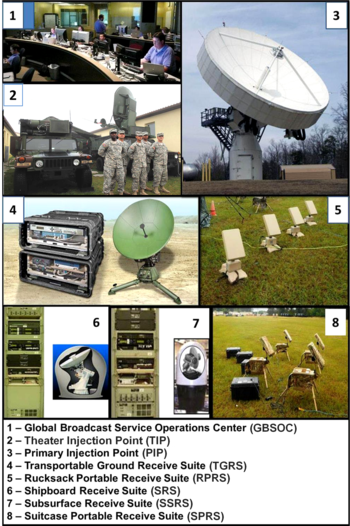Global Broadcast Service
Technical problems with transmit suite software, transportable and fixed receive suite design, and subsequent program delays led to a Joint Requirements Oversight Council decision to defer a small subset of capabilities, field the system with non-deferred capabilities, and then incrementally field upgrades until all the operational requirement thresholds were met and IOC declared.
[5] GBS consists of a SBM, co-located with DISA's DECC, and a variety of Receive Broadcast Managers (RBMs) owned and operated by the military services and other government agencies.
The SBM, Primary and Theater Injection Points (PIP and TIP), and DoD Teleport Gateways will then generate IP-based broadcasts for transmission over UFO and WGS satellites to be received by units equipped with RBMs, with up to 45 Mbps, that is designed to provide users with a broad range of bandwidth-intensive products without loading traditional command and communication networks.
[1][2] Deployed users can subscribe to large-volume national products --such as full motion video from unmanned aerial vehicles, digital maps, satellite imagery, and much more-- using net-centric prioritized delivery based on unit mission reception priority profiles.
[1][2] The SBM is the primary broadcast content site through which information and products are transmitted once to the satellite via PIPs and teleport gateways and received by multiple RBMs saving valuable bandwidth and time.


